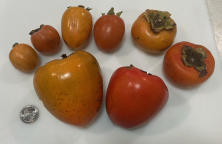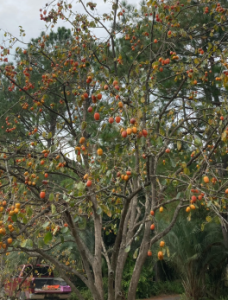Did you ever feel like you had a burning secret, something that you wanted to scream to the world because it is so good, yet so few people knew about it? This is how I feel about persimmons. I’ll scream here.
While they are a spectacular fruit borne of relatively low-maintenance trees, persimmons unfortunately reside in the “something I once heard about but never tried” file, for most consumers. Persimmons offer a diversity of flavors and textures, coupled to incredible sweetness in a fresh fruit.
There are a few reasons they are relatively unknown. First, they are extremely fragile, especially when ripe. You are unlikely to find them in a major grocery store, and even farmers markets rarely carry the delicate, fully-ripe fruit. Next, they are harvested in a short season, typically over a few weeks in the fall. Lastly, many folks cringe at the idea of eating a persimmons because they heard a horror story of their puckering astringency, a problem when some persimmons are eaten unripe. One man I met at a farmers market said, “Back when I was a kid we’d throw them at each other, that’s about all they’re good for.”
But despite his objections, enthusiasts will tell you that the taste of a ripe persimmons is worth the trip to a farmers’ market, farmstand or potentially a local U-pick. Persimmons should be near the top of your fruit bucket list.

Types of Persimmons
There are several major types of persimmons that fall into three main categories– Asian, North American and hybrids between the two. From there, they are classified as astringent or non-astringent.
Native Persimmons
Diospyros virginiana is the North American persimmons, found in the southeast USA in forests east from Texas and Oklahoma, and south of central Illinois through Pennsylvania. These trees produce small, seedy fruits that fall from the tree when ripe. They are a favorite for deer, squirrels and other wildlife. There have been some efforts to genetically improve D. virginiana resulting in a series of larger-fruited varieties. One Florida find is referred to as “Turkey Lake” a selection identified from a population growing in Orlando, FL. Others were bred from trees in the northern part of its range, including “Prok”, “Meader” and “Russian Beauty”. D. virginiana are astringent persimmons, meaning the must be eaten while fully ripe, only when the fruits are deep orange, extremely soft like a water balloon, and gooey inside.
Asian Persimmons (non-astringent)
The first major subtype of Asian persimmons (Diospyros kaki) is the non-astringent fruit. Non-astringent persimmons are typically shaped like a squat apple. They are sweet and flavorful when firm, even when unripe. They may be eaten out of hand or even marinated and cooked the grill. Common varieties include Fuyu, Jiro Fuyu, Matsumoto, Izu, and Ichi Ki Kei Jiro. The last two are dwarf trees that produce in late summer/early fall.

Asian Persimmons (astringent)
Astringent persimmons are a favorite for those that crave sweetness in fruit. They accumulate tannins when unripe, which if consumed, lead to a bitter, undesirable mouth-puckering sensation. However, if you can wait until they are soft as an overripe tomato, the contents are best described as honey fruit pulp. Some examples include Saijo (image to the left), a vigorous, rapidly growing tree that produces large numbers of fruits about the size and shape of a Roma tomato, Hachiya, a larger fruit about 4 inches in diameter, and Giombo, a heart-shaped fruit that ripens to a brilliant orange color with exceptional flavor and sweetness. Other varieties include Ormond, Honan Red and a Spanish variety called Rojo Brilliante.
Hybrid Persimmons
There are varieties of persimmons resulting from crossing North American with Asian persimmons. One example is Nakita’s Gift (technically Nikitskaya Bordovaya in Ukranian), bred in the Nakita Botanical Garden in Yalta, Ukraine. It has the shape of a Fuyu, and is small, approximately 3 inches in diameter. It also is astringent, so it must be eaten fully ripe. It is a smaller tree that produces beautiful fall foliage.
Persimmons in the Home Yard or Garden
Most D. virginiana persimmons trees require space, as they can grow to 30-60 feet tall and up to 30 feet wide. Asian varieties are typically smaller, up to 30 feet. Some varieties, like Izu, “Itchy”and Nakita’s Gift, grow to a shorter stature and work well in small spaces. For some varieties there are male and female trees, so both are required for fruit set. However, most the commonly cultivated Asian varieties are seedless and do not require pollinator trees. Young trees are typically grafted from known varieties onto D. virginiana rootstocks, and tolerate a wide range of soils. Newly planted trees benefit from frequent watering and seem to establish better than larger trees. While not an issue in Florida, range is limited by temperature, as most cannot survive temperatures below 0°F.
In Conclusion
Persimmons are easy to grow in Florida and are delicious, and should be a candidate for any home fruit tree. The biggest problem is the battle with squirrels, racoons and deer that know when a spectacular fruit is ripe to be picked. However, the fruit are abundant and there’s usually enough to share with animal friends. You can find trees at many local nurseries and online retailers, and they are a wonderful investment you will wish you would have planted a decade ago.
For more information please consult the University of Florida EDIS publications on Japanese Persimmons
Featured image on top by Judi Cain.
Source: UF/IFAS Pest Alert
Note: All images and contents are the property of UF/IFAS.



